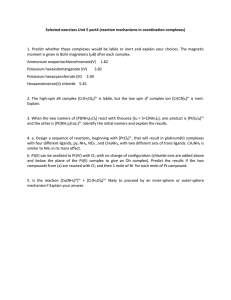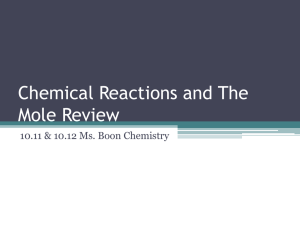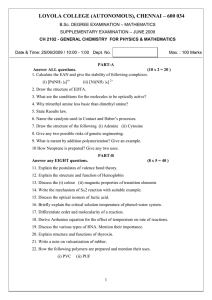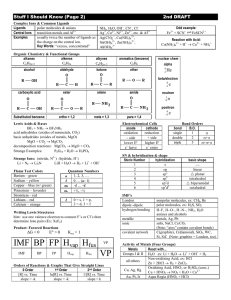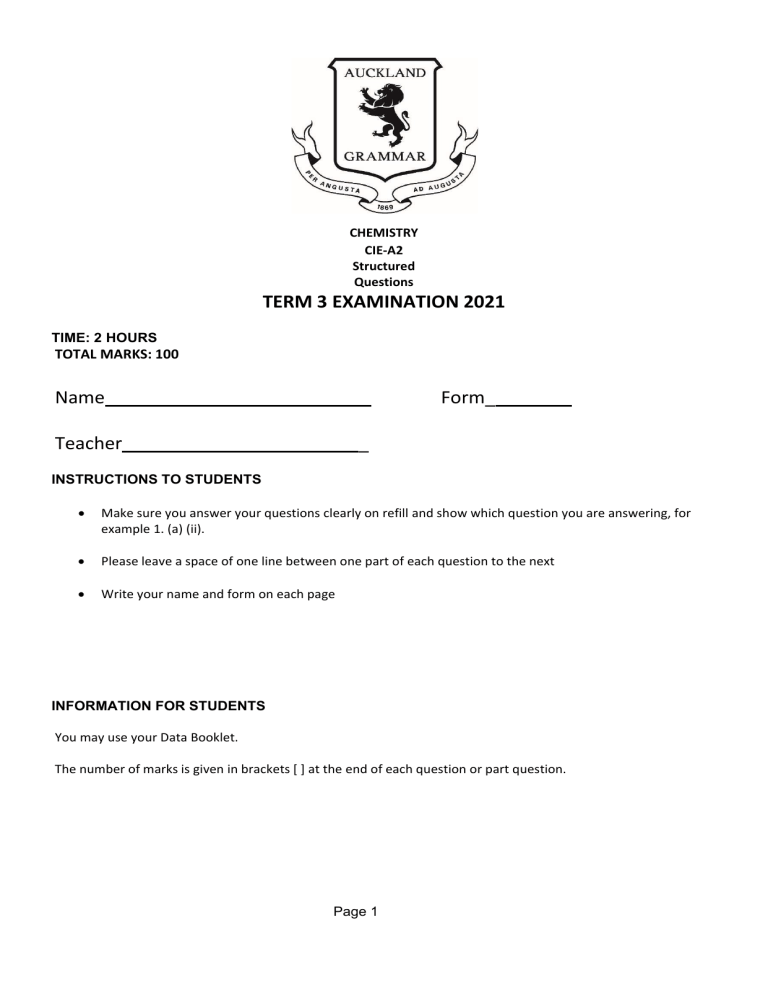
CHEMISTRY CIE‐A2 Structured Questions TERM 3 EXAMINATION 2021 TIME: 2 HOURS TOTAL MARKS: 100 Name Form_ Teacher _ INSTRUCTIONS TO STUDENTS Make sure you answer your questions clearly on refill and show which question you are answering, for example 1. (a) (ii). Please leave a space of one line between one part of each question to the next Write your name and form on each page INFORMATION FOR STUDENTS You may use your Data Booklet. The number of marks is given in brackets [ ] at the end of each question or part question. Page 1 2 Answer all the questions in the spaces provided. 1 The compound nitrosyl bromide, NOBr, can be formed by the reaction shown. 2NO + Br2 2NOBr (a) Using oxidation numbers, explain why this reaction is a redox reaction. .................................................................................................................................................... .................................................................................................................................................... .............................................................................................................................................. [2] (b) Nitrosyl bromide contains a trivalent nitrogen atom. Draw the ‘dot-and-cross’ diagram for NOBr. Show outer electrons only. [2] (c) The rate of the reaction was measured at various concentrations of the two reactants, NO and Br2, and the following results were obtained. experiment [NO] / mol dm–3 [Br2] / mol dm–3 initial rate / mol dm–3 s–1 1 0.03 0.02 3.4 10–3 2 0.03 0.04 6.8 10–3 3 0.09 0.04 6.1 10–2 4 0.12 0.06 to be calculated The general form of the rate equation for this reaction is as follows. rate = k [NO]a[Br2]b (i) What is meant by the term order of reaction with respect to a particular reagent? ............................................................................................................................................. ....................................................................................................................................... [1] 3 (ii) Use the data in the table to deduce the values of a and b in the rate equation. Show your reasoning. ............................................................................................................................................. ............................................................................................................................................. ............................................................................................................................................. ....................................................................................................................................... [2] (iii) Use the data in the table to calculate the initial rate for experiment 4. initial rate = .............................. mol dm–3 s–1 [1] (iv) Use the results of experiment 1 to calculate the rate constant, k, for this reaction. Include the units of k. rate constant, k = ............................. units ............................... [2] (v) By considering the rate equation, explain why the rate decreases with decreasing temperature. ............................................................................................................................................. ....................................................................................................................................... [1] (d) The reaction between X and Y was studied. 2X + Y Z The following sequence of steps is a proposed mechanism for the reaction. step 1 step 2 2X V V + Y Z The general form of the rate equation for this reaction is as follows. rate = k [X]m[Y]n Step 1 is the slower step in the mechanism. Deduce the values of m and n in the rate equation. m = .................................................................. n = ................................................................. [1] [Total: 12] [Turn over 4 2 (a) The table lists values of solubility products, Ksp, of some Group 2 carbonates. solubility product in water at 298 K, Ksp / mol2 dm–6 MgCO3 1.0 10–5 CaCO3 5.0 10–9 SrCO3 1.1 10–10 Use the data in the table to describe the trend in the solubility of the Group 2 carbonates down the group. .................................................................................................................................................... .............................................................................................................................................. [1] (b) (i) Write an equation to show the equilibrium for the solubility product for MgCO3. Include state symbols. ....................................................................................................................................... [1] (ii) With reference to your equation in (i), suggest what is observed when a few cm3 of concentrated Na2CO3(aq) are added to a saturated solution of MgCO3. Explain your answer. ............................................................................................................................................. ............................................................................................................................................. ....................................................................................................................................... [2] (c) Use the data in the table to calculate the solubility of MgCO3 in water at 298 K, in g dm–3. solubility of MgCO3 = ............................. g dm–3 [2] 5 (d) (i) Magnesium nitrate decomposes at a lower temperature than barium nitrate. Explain why. ............................................................................................................................................. ............................................................................................................................................. ....................................................................................................................................... [2] (ii) A sample of barium nitrate was heated strongly until no further change occurred. A white solid was formed. Write an equation for the action of heat on barium nitrate. ....................................................................................................................................... [1] (iii) When water was added to the white solid produced in (d)(ii), an alkaline solution was produced. Adding sulfuric acid to this solution produced a white precipitate. Write equations to explain these observations. ............................................................................................................................................. ....................................................................................................................................... [2] [Total: 11] [Turn over 6 3 (a) Define the term standard cell potential. .................................................................................................................................................... .................................................................................................................................................... .............................................................................................................................................. [2] (b) (i) Draw a fully labelled diagram of the experimental set-up you could use to measure the standard electrode potential of the Pb2+(aq) / Pb(s) electrode. Include the necessary chemicals. [4] (ii) The E o for a Pb2+(aq) / Pb(s) electrode is – 0.13 V. Suggest how the E for this electrode would differ from its E o value if the concentration of Pb2+(aq) ions is reduced. Indicate this by placing a tick ( ) in the appropriate box in the table. more negative no change less negative Explain your answer. ............................................................................................................................................. ............................................................................................................................................. ....................................................................................................................................... [2] 7 (c) Car batteries are made up of rechargeable lead-acid cells. Each cell consists of a negative electrode made of Pb metal and a positive electrode made of PbO2. The electrolyte is H2SO4(aq). When a lead-acid cell is in use, Pb2+ ions are precipitated out as PbSO4(s) at the negative electrode. Pb(s) + SO42–(aq) (i) PbSO4(s) + 2e– Calculate the mass of Pb that is converted to PbSO4 when a current of 0.40A is delivered by the cell for 80 minutes. mass of Pb = .............................. g [2] (ii) Complete the half-equation for the reaction taking place at the positive electrode. PbO2(s) + SO42-(aq) + ……………. + …………… PbSO4(s) + …………….. [1] (d) The diagrams show how the voltage across two different cells changes with time when each cell is used to provide an electric current. lead-acid cell voltage / V H2 / O2 fuel cell voltage / V time / hours time / hours Suggest a reason why ● the voltage of the lead-acid cell changes after several hours, .................................................................................................................................................... .................................................................................................................................................... ● the voltage of the fuel cell remains constant. .................................................................................................................................................... .................................................................................................................................................... [2] [Total: 13] [Turn over 8 4 (a) Describe and explain how the density and melting point of cobalt compare to those of calcium. density of cobalt ......................................................................................................................... explanation ................................................................................................................................ .................................................................................................................................................... melting point of cobalt ................................................................................................................ explanation ................................................................................................................................ .................................................................................................................................................... [3] (b) Transition metals can form complexes. What is meant by the term transition metal complex? .................................................................................................................................................... .............................................................................................................................................. [1] (c) (i) Cobalt can form the compounds [Co(NH3)5Br]SO4 and [Co(NH3)5SO4]Br. These two compounds are structural isomers. Define the term structural isomer. ............................................................................................................................................. ....................................................................................................................................... [1] (ii) Draw a three-dimensional diagram to show the structure of the ion [Co(NH3)5Br]2+. Name its shape. [Co(NH3)5Br]2+ shape ............................................................................................................................... [1] (iii) State the type of bonding between the cobalt ion and NH3 groups in the [Co(NH3)5Br]2+ ion. ....................................................................................................................................... [1] 9 (iv) State the oxidation number of cobalt in ● [Co(NH3)5Br]2+ oxidation number of Co = .............................. ● [Co(NH3)5SO4]+ oxidation number of Co = .............................. [1] (d) Solutions of the compounds [Co(NH3)5Br]SO4 and [Co(NH3)5SO4]Br can be distinguished from each other by simple chemical tests. Assume that any species bonded to the cobalt ion does not react in these tests. Complete the table with two different tests that could be used to positively identify each compound. Give the expected observation with each compound. test observation with [Co(NH3)5Br]SO4(aq) observation with [Co(NH3)5SO4]Br(aq) [2] (e) The two compounds [Co(NH3)5Br]SO4 and [Co(NH3)5SO4]Br are different colours. Explain why the colours of the two compounds are different. .................................................................................................................................................... .................................................................................................................................................... .............................................................................................................................................. [2] (f) Some transition metals and their compounds act as catalysts. The catalysis can be classified as heterogeneous or homogeneous. Complete the table by placing one tick (√) in each row to indicate the type of catalysis in each reaction. heterogeneous homogeneous Fe in the Haber process Fe2+ in the I– / S2O8 2– reaction NO2 in the oxidation of SO2 V2O5 in the Contact process [2] [Total: 14] [Turn over 10 5 Compound P contains several functional groups. (a) Name the functional groups present in P. .................................................................................................................................................... .............................................................................................................................................. [2] (b) Compound P can be polymerised. Draw a section of the polymer of P showing two repeat units. Name the type of polymerisation. type of polymerisation ................................................................................................................ [2] 11 (c) Complete the following table to show the structures of the products formed and the type of organic reaction when P reacts with the four reagents. reagent structure(s) of product(s) type of organic reaction excess Br2(aq) excess hot, concentrated, acidified MnO4 (aq) – excess hot HCl (aq) excess H2 / Pt catalyst [8] [Total: 12] [Turn over 12 6 (a) 4-nitromethylbenzene can be prepared via an electrophilic substitution reaction as shown. CH3 CH3 CH3 conc. HNO3 conc. H2SO4 H methylbenzene (i) NO2 intermediate T NO2 4-nitromethylbenzene This reaction also forms an isomer of 4-nitromethylbenzene as a by-product. Draw the structure of this by-product. [1] (ii) Write an equation for the reaction between HNO3 and H2SO4 that forms the electrophile for this reaction. ....................................................................................................................................... [1] (iii) Describe how the structure and bonding of the six-membered ring in intermediate T differs from that in methylbenzene. ............................................................................................................................................. ............................................................................................................................................. ............................................................................................................................................. ....................................................................................................................................... [3] 13 (b) Benzocaine is used as a local anaesthetic. It can be synthesised from 4-nitromethylbenzene by the route shown. (i) Give the systematic name of compound W. ....................................................................................................................................... [1] (ii) Suggest the reagents and conditions for steps 1– 5. step 1 .................................................................................................................................. step 2 .................................................................................................................................. step 3 .................................................................................................................................. step 4 .................................................................................................................................. step 5 .................................................................................................................................. [6] (c) Suggest how the basicity of benzocaine would compare to that of ethylamine. Explain your answer. .................................................................................................................................................... .................................................................................................................................................... .............................................................................................................................................. [2] [Turn over 14 (d) A sample of benzocaine, shown below, was analysed by proton NMR and carbon-13 NMR spectroscopy. (i) Predict the number of peaks that would be seen in the carbon-13 NMR spectrum. ....................................................................................................................................... [1] (ii) Benzocaine was dissolved in CDCl 3 and the proton NMR spectrum of this solution was recorded. CO2CH2CH3 NH2 benzocaine 8 7 6 5 4 / ppm 3 2 1 0 Suggest why CDCl 3 and not CHCl 3 is used as the solvent when obtaining a proton NMR spectrum. ............................................................................................................................................. ....................................................................................................................................... [1] (iii) Use the Data Booklet and the spectrum in (d)(ii) to complete the table for the proton NMR spectrum of benzocaine. The actual chemical shifts, , for the four absorptions havebeen added. / ppm group responsible for the peak number of 1H atoms responsible for the peak splitting pattern 1.2 3.5 5.5 7.1–7.4 multiplet [4] (iv) Explain the splitting pattern for the absorption at 1.2 ppm. ............................................................................................................................................. ....................................................................................................................................... [1] 15 (v) The proton NMR spectrum of benzocaine dissolved in D2O was recorded. Suggest how this spectrum would differ from the spectrum in (d)(ii). Explain your answer. ............................................................................................................................................. ....................................................................................................................................... [1] (e) Benzocaine can also be used to synthesise the dyestuff S by the following route. CO2CH2CH3 step 1 NH2 R benzocaine step 2 NaOH(aq), OH phenol S (i) Suggest the reagents used for step 1. ....................................................................................................................................... [1] (ii) Suggest structures for compounds R and S and draw them in the boxes. [2] [Total: 25] [Turn over 16 7 (a) Complete the following electronic structures. ● the iron atom, Fe 1s22s22p6 .............................. ● the iron(III) ion, Fe3+ 1s22s22p6 .............................. [1] (b) Solutions of iron(III) salts are acidic due to the equilibrium shown. [Fe(H2O)6]3+(aq) [Fe(H2O)5(OH)]2+(aq) + H+(aq) Ka = 8.9 10–4 mol dm–3 Calculate the pH of a 0.25 mol dm–3 FeCl 3 solution. pH = ................................ [2] (c) The table shows numerical values of the stability constants for the following equilibrium where M can be one of the metal ions listed and L one of the ligands which replaces one H2O molecule. [M(H2O)6]n+(aq) + L–(aq) (i) [M(H2O)5L](n–1)+(aq) + H2O(l) metal ion, M ligand, L stability constant, Kstab Fe3+ F– 1.0 106 Fe3+ Cl – 2.5 101 Fe3+ SCN– 9.0 102 Hg2+ Cl – 5.0 106 What is meant by the term stability constant, Kstab? ............................................................................................................................................. ....................................................................................................................................... [1] (ii) Use the data in the table to predict the formula of the complex formed in the greatest amount when ● a solution containing equal concentrations of both F– and SCN– ions is added to Fe3+(aq), ............................................................................................................................................. ● a solution containing equal concentrations of both Fe3+ and Hg2+ ions is added to Cl –(aq). ............................................................................................................................................. [1] 17 Ethanedioate ions, –O2CCO 2–, are bidentate ligands. The abbreviation ed 2– can be used to represent ethanedioate ions. (d) The complex [Fe(ed )2Cl 2]3– can be formed according to the equation shown. [Fe(H2O)4Cl 2]+(aq) + 2ed 2–(aq) [Fe(ed )2Cl 2]3–(aq) + 4H2O(l) Write the expression for the equilibrium constant, Kstab, and state its units. Kstab = units .............................. [2] (e) [Fe(ed )2Cl 2]3– shows geometrical and optical isomerism. (i) Complete the three-dimensional diagrams to show the three stereoisomers of [Fe(ed )2Cl 2]3–. You may use –O 2– O– to represent ed . Fe Fe isomer A isomer B Fe isomer C [3] (ii) Give the letters of two isomers of [Fe(ed )2Cl 2]3– which are geometrical isomers of each other. ....................................................................................................................................... [1] (iii) Give the letters of the two isomers of [Fe(ed )2Cl 2]3– which show optical isomerism. ....................................................................................................................................... [1] (iv) Give the letter of the isomer which has no dipole moment. ....................................................................................................................................... [1] [Total: 13] [Turn over 18 BLANK PAGE 19 BLANK PAGE 20 BLANK PAGE




